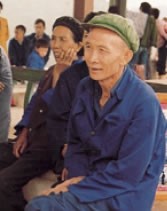Han Chinese, Shaojiang in China

Photo Source:
Copyrighted © 2025
Operation China, Asia Harvest All rights reserved. Used with permission |
Send Joshua Project a map of this people group.
|
| People Name: | Han Chinese, Shaojiang |
| Country: | China |
| 10/40 Window: | Yes |
| Population: | 906,000 |
| World Population: | 906,000 |
| Primary Language: | Chinese, Shaojiang |
| Primary Religion: | Non-Religious |
| Christian Adherents: | 4.30 % |
| Evangelicals: | 3.70 % |
| Scripture: | Translation Needed |
| Ministry Resources: | No |
| Jesus Film: | No |
| Audio Recordings: | No |
| People Cluster: | Chinese |
| Affinity Bloc: | East Asian Peoples |
| Progress Level: |
|
Introduction / History
The members of the Shaojiang Chinese language group are considered part of the Han Chinese nationality, but they speak a language not understood by any other Chinese people.
The Ming Dynasty (1368-1644): Until 1420 the Ming Dynasty rulers used Nanjing as its capital, until Yongle, the second Ming emperor, reestablished the capital in Beijing, where it has remained until today. China slowly found its feet again after the violent reign of the Mongols. The first Ming emperor, Hongwu, is remembered for putting to death 10,000 scholars and their families in two purges. For the first time, China became a maritime nation. Zhang He "undertook seven great expeditions that took him and a huge fleet to Southeast Asia, Persia, Arabia and even eastern Africa." Corruption, famine and costly wars against the Japanese brought the country to bankruptcy and sparked an uprising that toppled the government.
What Are Their Lives Like?
The Shaojiang Chinese live like any other Han Chinese group.
What Are Their Beliefs?
Many elderly Shaojiang follow Buddhist and Daoist teachings, while most Shaojiang youth are atheists.
The first Catholic missionary in China was John of Montecorvino, who constructed a magnificent church in Beijing in 1299. The jealous Nestorians called John a "spy, magician, and deceiver of men." By 1305 he had won 6,000 converts. John claimed, "And if not for the above-named slanders, I should have baptized more than 30,000." One historian states, "Almost single-handedly [John] established the Roman Catholic faith in the capital of the mightiest empire of his time." At the time of his death in 1328, there were 100,000 Catholic converts across China.
What Are Their Needs?
The Shaojiang Chinese churches need a new, fresh work of the Holy Spirit.
Prayer Points
Pray for Shaojiang Chinese disciples to make more disciples.
Pray for Shaojiang Chinese Christians to pray and go to the lost peoples to their west.
Pray for the Lord to abundantly bless Shaojiang Chinese families with his abundant grace, mercy and love.